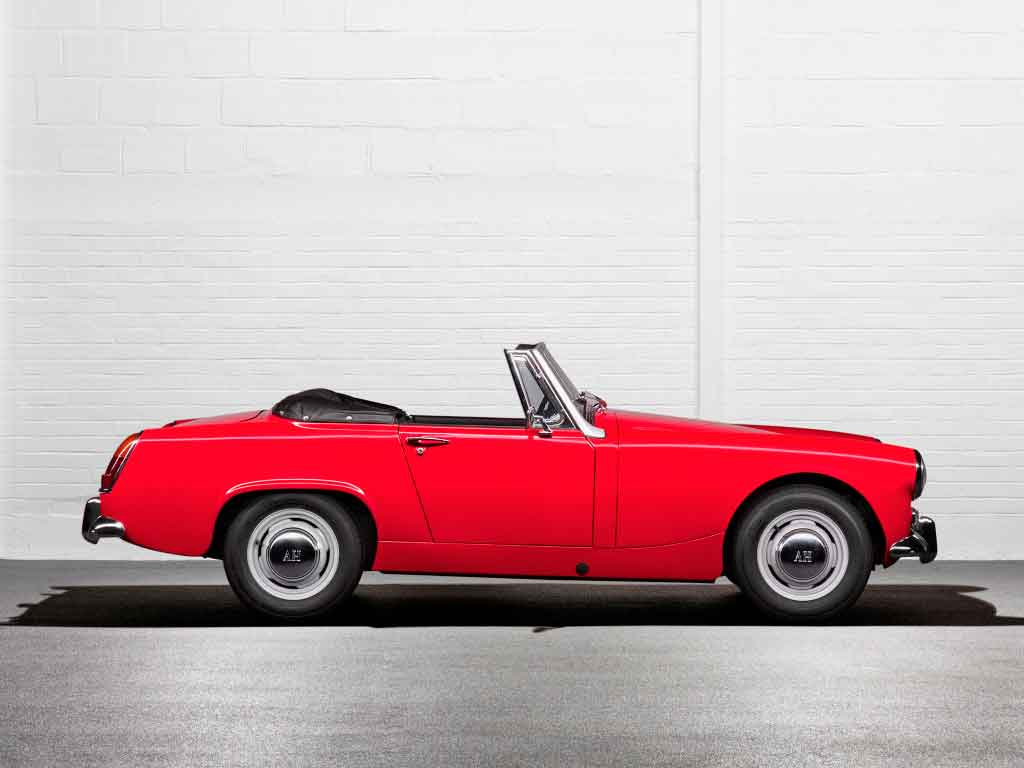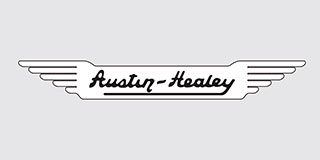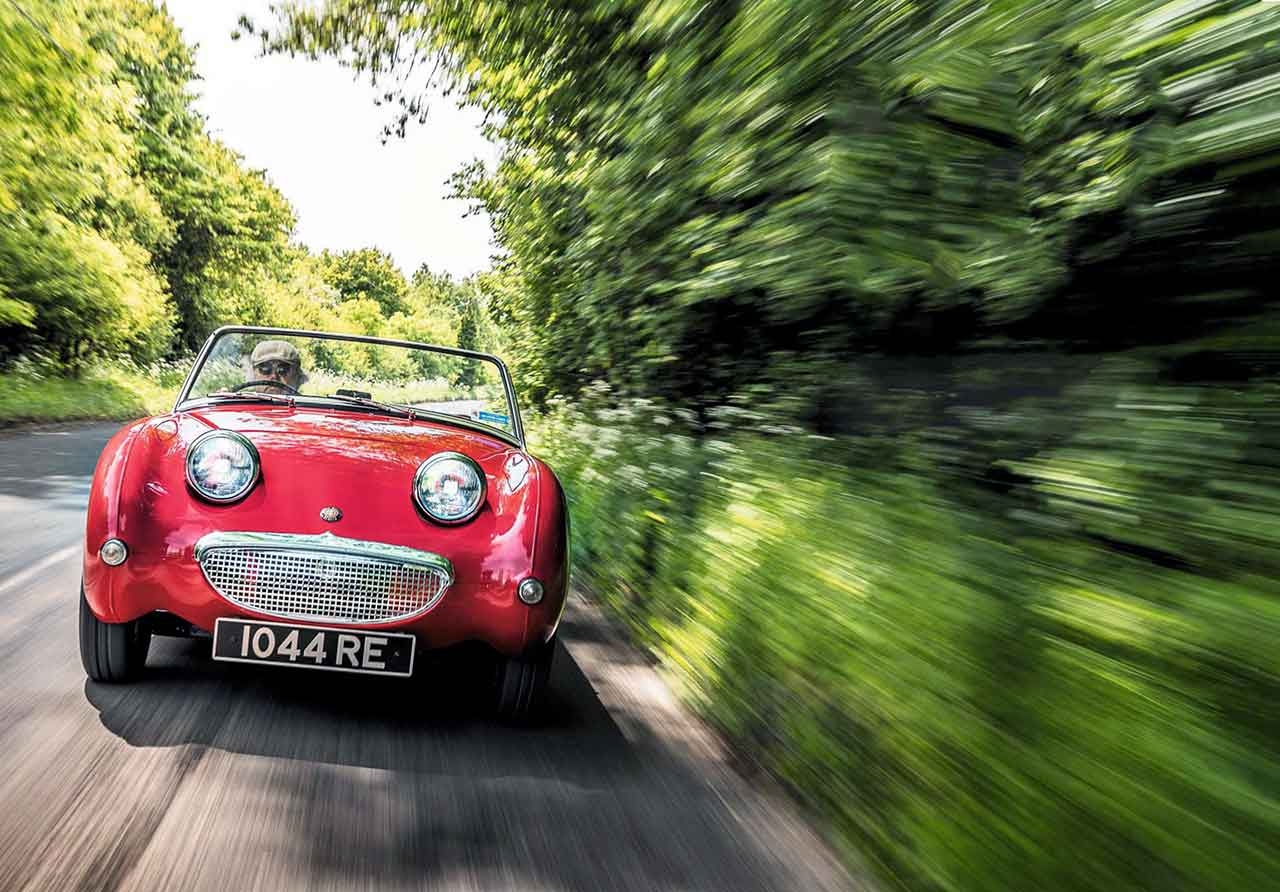
Happy 60th! Austin-Healey revolutionised the sports car market with its nimble and affordable Sprite. To celebrate the model’s 60th anniversary we take one back to BMC’s original test route. Words Ross Alkureishi. Photography Alex Tapley.
Happy 60th! …to the Austin-Healey Sprite, sports-car game-changer. Sprite 60th anniversary drive. Small car, big birthday – we celebrate the Austin-Healey Sprite in its purest form.
First impressions are not good. It’s cute enough, but the Austin-Healey ‘Frogeye’ Sprite sitting outside specialist Mike Authers’ Oxfordshire premises could be described by the word dinky, or perhaps minute. Alternatively there’s wee or any number of other adjectives that emphasise its lack of proportions. It’s not as if any of these could be applied to my own frame – I have a fairly lofty 6ft 2in to shoehorn in. Reaching for the door handle is a mistake because there isn’t one. Nor a bootlid. But 60 years ago this was Donald Healey and Leonard Lord’s low-cost sports car, so forget what you know about automobiles and go with the budget low.
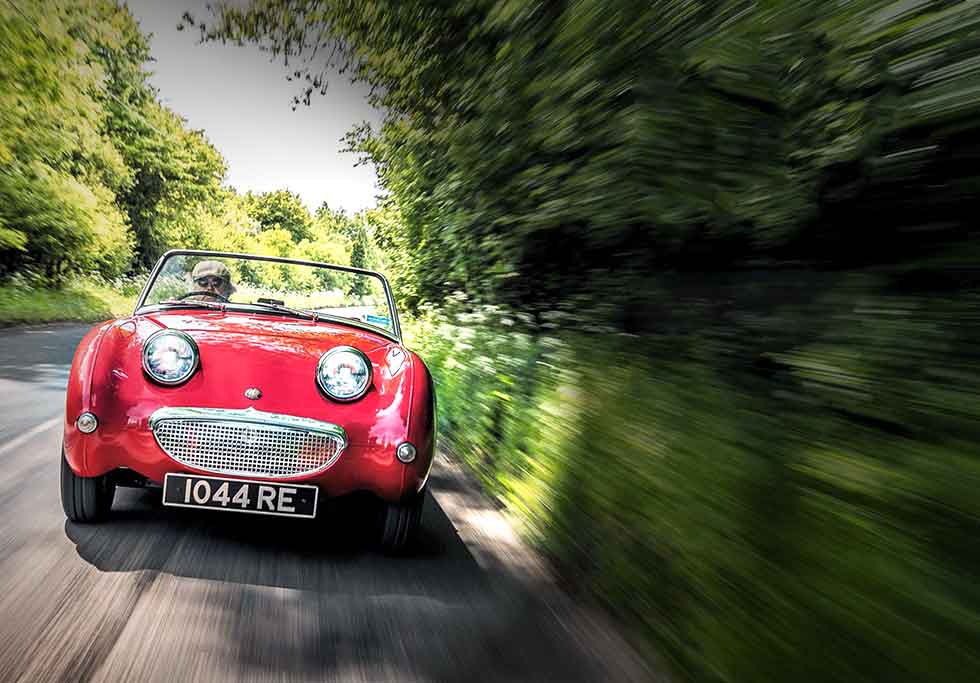
Instead, my celebratory mission to retrace some of the original MG test routes begins with reaching into the hollow door shell to pop it open. Hmm, that large two-spoke steering wheel is the antithesis of sporty. In fact it’s exactly what you’d expect to find in the Sprite’s Austin A35 parts donor, and a distinct barrier to elegant ingress.
It takes me three attempts, accompanied mentally by the lyrics of one of my daughter’s favourite songs, ‘Left-cheek, right-cheek, left-cheek, right-cheek’ as I contort, manipulate and finally find… a surprisingly comfortable seating position and generously long footwell, albeit with the pedals slightly offset to the right. I reckon any prospective driver would have to hit 6ft 5in before incurring a problem – it’s positively Tardis-like in here.
Like the exterior, the cabin is very basic. There are a pair of bucket seats, Smiths gauges – including a tachometer which along with the heater and demister, screen washer, radio and front bumper would have been optional extras – plus a big helping of exposed body-coloured metal (all the rage today, of course) to brighten things up.

Mike jumps into the passenger seat. Who better to share this journey of discovery with than Mr Spridget himself? He’s been buying, selling and fettling them since the early Eighties. Once in, he hands me a clothes peg. Eh?
Confused, I pull the choke knob out slightly and it promptly retracts back in. I try again, with a similar result. Eureka! Left-hand-pull, right-hand- peg application. ‘All Sprite drivers have one,’ Mike explains.
It fires on a pull of the starter knob, the 948cc overhead-valve four eliciting a cheeky induction whoof through its twin pancake-type Cooper air filters with an accompanying mischievous exhaust parp on throttle blip. The tall rigid gearlever engages first cog with a surprisingly short throw and we’re of. Our first destination is the site of the former MG factory at Abingdon, where the Sprite was built alongside older sibling, the Austin-Healey 100.
As I tootle out of Mike’s farm-based premises, however, first driving impressions are good. After chirruping away of the line the engine is proving an eager tyke, responding perkily to my right foot promptings. With a 0-60mph time of 20.2sec (deceptive, because the first 50 comes up in just 14sec) and a top speed of only 86mph it’s by no means a high-speed demon, but with just shy of 700kg to thrust forward and your bum practically skimming the tarmac it feels bloomin’ fast.
Better still is the steering. Forget that oversized wheel, which is compensated by the immediacy of feel on offer. Instead of the expected oodles of play at the straight-ahead, the Morris Minor sourced rack-and-pinion unit is Angel Delight light yet still manages to feel wonderfully precise. It’s surprisingly high-geared with just two and quarter turns lock-to-lock and on all but the tightest corners requires only small steering inputs.
It doesn’t take long before I’m accustomed to driving the Sprite – spin the engine up to 6000rpm, up-shift the snappy, well-defined close-ratio ’box and nip spiritedly through on to the next bend. Even the drum brakes feel up to the job. As we pull into the old MG site Authers asks me my thoughts on our journey so far. ‘It’s so easy to drive – urgent, precise and perky. The scuttle shake, or absolute lack of it, is a real surprise given the era when it was built. What a remarkable little car,’ I reply.
Less remarkable is the modern business park that faces us. We stop and wander over to a single-storey building labelled Marketing Suite at Abingdon Business Park’s entrance. ‘It’s a real shame,’ says Mike. ‘Even until a few years ago quite a lot of the factory buildings remained, but it was sold to Standard Life and all that remains is this plaque.’
It’s the only reminder of what was once a thriving automotive hub employing thousands and it feels somewhat inadequate given all that history. Still, without getting too maudlin, it will provide the starting point for our onward journey. Armed with an MG Car Club PDF of the old factory test routes, we plan to follow the red route designated by MG for late Forties vehicles.
Back at the Sprite I get in and this time ire it up intuitively, using the left hand, right hand procedure, then whip round out of the car park, and we’re of. Glorious sunshine, a back-to-basics Fifties roadster, the original test roads and great company, it doesn’t get better than this – for 20 yards or so, when that modern affliction, the speed bump, means slowing to a virtual standstill. Once past that obstacle we zip through a couple of roundabouts and are heading east along the A415. We travel under the Abingdon bypass, the Sprite’s exhaust echoing impudently, and turn right onto Faringdon Road. At 60mph and with only four gears to play with, driving can become decidedly busy – you sense motorways would be a trial rather than a pleasure.
We fizz past the Black Horse public house and, approaching Sheepstead Crossroads, Mike cautions me to slow. ‘That’s us,’ he says, signalling for a turnaround with his right hand. The Sprite’s tiny turning circle sees us speedily on our way back, and after just 12 minutes we’re back exactly where we started.
‘That’s all?’ I ask. ‘That was the test route for Sprites?’ It was, confirms Mike. ‘It’s not much,’ he acknowledges. ‘To be honest, a lot of the shakedown would have been left for the dealers to carry out.’ At that we park up and head to a local café where he’s arranged for us to meet his mechanic Geoff Clark for a cuppa. Geoff joined MG straight from school in 1959, completing his apprenticeship before working in the chassis frame section of the Development Department.
Although he joined the company two years after the MkI Sprite’s arrival, as part of his grounding in the model he recalls discussing the problems that had arisen prior to it going on sale and the requisite steps the design team had taken to rectify them.
‘It had initial issues when tested on the MIRA pavé,’ he says. Production had already started when these came to light, as MG’s Don Hayter – later designer of the MGB – put a number of heavily laden examples through their paces. ‘They were breaking up a bit at the rear bulkhead and required significant strengthening, with plates and brackets added,’ recalls Geoff. Maybe that test route wasn’t adequate after all.
Geoff believes the improved structure that emerged after Hayter’s tests is what made the Sprite such a formidable road car and racer. ‘It was a stiff monocoque without a doubt,’ he adds. ‘Up until then you had the MGA and the like with separate body and chassis, and they’d flex. But the Sprite handled incredibly from the of. It didn’t take much to turn a standard Sprite into a decent club racer – a bit more power, a roll bar and some uprated shocks. I think that’s why they were so popular.’
Clark also remembers being given the job of converting the MkIII Sprite and its MG equivalent, the MkII Midget, to half-elliptic suspension. ‘The change from a quarter-elliptic arrangement transformed the ride, which was now softer and not as stiff or uncomfortable as the earlier cars. There was also more room for adjustment.’
That’s not something we need concern ourselves with today as we drive Mike Authers’ own immaculate 12,000-mile MkI. And after completing the short test route, I’m barely sated. We say goodbye to Geoff and immediately get back out on the road. This time we return to the late Forties route then continue on to the extension of the later V8 route. Back at the start once more, we hit the pre-war route. But they’re similarly undemanding and only adequate for checking that the cars were screwed together OK.
I think it’s time to head out into the Oxfordshire countryside and Mike agrees. On quieter B-roads I start pushing the little Sprite a bit harder and it responds purposefully. It’s fairly neutral through corners and handles sharp changes of direction with contemptuous ease.
Blasting through an S-bend, a sudden camber change unsettles the rear end and it skips momentarily like a pebble skimming across a pond. ‘That’s what Geoff was talking about,’ says Authers. ‘A later car with semi-elliptic suspension wouldn’t do that.’ It’s a bit disconcerting the first time it happens but a part of the Frogeye driving experience.
I must admit I’m quite taken with the little Sprite and the view over that cheeky bonnet. I can see why so many buyers opted for one when it was first released. That low price, coupled with the drive, proved an irresistible combination with just shy of 50,000 MkIs sold in three years of production – numbers that must surely have surprised even the project’s founding fathers.
BMC chairman Leonard Lord first proposed the idea for a low-budget sports car to Donald Healey at the 1956 Motor Show. The Austin-Healey 100 had proved a great success and the junior car would follow a similar cost-saving concept of making use of existing components.
The A-series engine, four-speed gearbox with synchromesh on second, third and fourth, front suspension and back axle casing all came from the Austin A35; the rack-and- pinion steering was from the Morris Minor; and the clutch and master cylinder were courtesy of MG.
To keep production costs tight a separate chassis was ditched in favour of monocoque construction with a large, one-piece lift-up bonnet. Barry Bilbie designed the chassis, overseen by Geoffrey Healey, with Gerry Coker responsible for the body. The latter left for America to work for Ford in 1957 and later admitted to being surprised when he saw the production version of the Sprite – without the planned retractable headlights of his original design and the Q1 prototype. ‘I nearly croaked. It looked like a headlamp test vehicle,’ was his initial verdict.
The Sprite’s press launch took place in Monte Carlo in 1958 – and why not? Eight years before the Lamborghini Miura debuted in the same exotic location, here was an altogether different proposition – hell, it even had a clamshell of sorts, albeit at the front. Reception for the diminutive new sports car was very positive, particularly on its price and driving qualities. The Motor commended BMC’s decision to ill the void for ‘the sort of small sports car that provided so much fun for so many now middle-aged drivers in their early motoring days’ and Motor Sport praised its ‘quite outstandingly good roadholding and cornering’.
The only issue was how it looked. ‘Rather amusing appearance’ and ‘headlamps that protrude like sore thumbs’ were some of the more polite press musings, while ‘the appearance of the Sprite is unfortunate’ seemed to sum up the general feeling. Today – despite later Sprites’ improved ride and more conventional front-end appearance – you’ll pay a hefty premium for a Frogeye.
‘Good, solid MkI Sprites are now worth £12k-£18k, with excellent examples in the low-£20k range, exceptional ones making up to £30k,’ says Mike. ‘The later Sprites and Midgets are half these values, with no price difference between an Austin-Healey and an MG.’
I must admit that I did feel a little conspicuous when I first climbed aboard, as if I was dressed in a suit that was several sizes too small. However, while a Lamborghini Diablo shrinks around you, the Sprite seems to expand the more you drive it; you become comfortable both in the cabin and in the way it drives, and you quickly forget its tiny dimensions.
Another thing I’ve noticed today is the reception it gets on modern roads – it’s a real crowd pleaser. ‘It’s so inoffensive,’ says Authers. ‘Women in particular just love them.’ On release it was the combination of affordability, tunability and tractability that appealed. That saw buyers forego its aesthetics to snap them up in droves.
Over the decades the Sprite remained the ultimate starter sports car and the fact that the Midget remained in production until 1980 demonstrated that the appetite for such a car remained long after the manufacturer’s original name had disappeared from the model.
But for me the Frogeye is the one to have. It’s cheeky, impudent and highly charismatic. Turning up at a classic car show in one is the equivalent of walking down a high street with a puppy. The passage of 60 years has ensured that after enduring the ‘It’s so cute’ and ‘Aw, bless’ of the crowd many will still be unaware of its abilities, until you release its inner B-road dervish and sit right on their tailpipes on the way home. No wonder it conquered the world.
Forget first impressions – it’s last ones that count.
Thanks to: Mike Authers Classics (mgmidgets.com)
Tech and photos
TECHNICAL DATA FILE SPECIFICATIONS 1958 Austin-Healey Sprite MkI
Engine 948cc, inline four-cylinder, ohv, two 1¼-inch SU carburettors
Max Power 46bhp @ 5500rpm / DIN net (metric)
Max Torque 53lb ft @ 3000rpm / DIN nett (metric)
Transmission Four-speed manual, rear-wheel drive
Steering Rack and pinion
Suspension Front: wishbones, coil-springs, lever-arm dampers. Rear: multi-leaf quarter-elliptic springs, radius arms, coil-springs, lever-arm dampers
Brakes Drums front and rear
Weight 664kg (1464lb)
Performance 0-60mph: 20.2sec;
Top Speed: 86mph
Fuel consumption 34mpg
Cost new £678 17s
Classic Cars Price Guide £4000-£25,000
‘Spin the engine up to 6000rpm, up-shift the close-ratio ’box and nip spiritedly on to the next bend’
‘It didn’t take much to turn one into a decent club racer – a bit more power, a roll bar and some uprated shocks’
‘Turning up at a classic car show in one is the equivalent of walking down the street with a puppy’
‘At 60mph and with only four gears to play with, driving can become decidedly busy’
‘It didn’t take much to turn one into a decent club racer – a bit more power, a roll bar and some uprated shocks’
The nimble 948cc Sprite is more a B-road charmer than motorway blaster. The Frogeye spawned a family of Sprites and Midgets; Mike Authers looks after all variants The Frogeye has put a smile on drivers’ and onlookers’ faces since its 1958 launch.
Headlamps were intended to pop up and down but cash constraints meant they ended up fixed. A-series engine is one of many key parts sourced from the Austin A35. No bootlid, no door handles, no fuss; just the essentials for making every corner a party.
Competition highlights
From the start it was clear the Sprite was a racy little number and its first competition victory arrived on March 31, 1958, in the Sporting Owner Drivers’ Club Millimar Rally.
Next up, from July 7-12 came an unlikely star turn as a rally car, with 1st, 2nd and 3rd in class in the Alpine Rally. The following year saw the model’s international debut at the Sebring Twelve-Hour race, with three heavily modified examples again taking a 1-2-3 in class.
BMC also took an aerodynamic-bodied special (‘EX 219’) to Bonneville Salt Flats, where it ran for 12 hours at an average 138.75mph, covering 1665 miles and sweeping up nine international Class G records.
Motor sport legends including Stirling Moss, Bruce McLaren, Briggs Cunningham and Paddy Hopkirk, as well as Hollywood racer Steve McQueen, successfully raced and rallied Sprites, with Graham Hill racing the first Speedwell – founded by British racer John Sprinzel – GT prototype in May 1959.
Further success at Sebring in 1960 followed in a glassfibre-bodied car, with Sprinzel and John Patten later achieving a class win in the Liège-Rome-Liège rally in a ‘Sebring’ Sprite.
Perhaps the Sebring Sprite’s greatest achievement was 12th overall at Le Mans in 1965 – not bad for such a diminutive car.
Sprite timeline
1958 MkI BMC raids its parts bin for A35 bits – including A-Series engine in 46bhp twin carburettor form – plus Morris Minor steering and MG clutch/ master cylinder. Simple unitary construction keeps price (£678 17s) and weight (664kg) low. Affordability and zesty performance sees 49,616 sold in just three years. Protruding headlights earn the model its ‘Frogeye’ nickname in the UK, ‘Bugeye’ in the US.
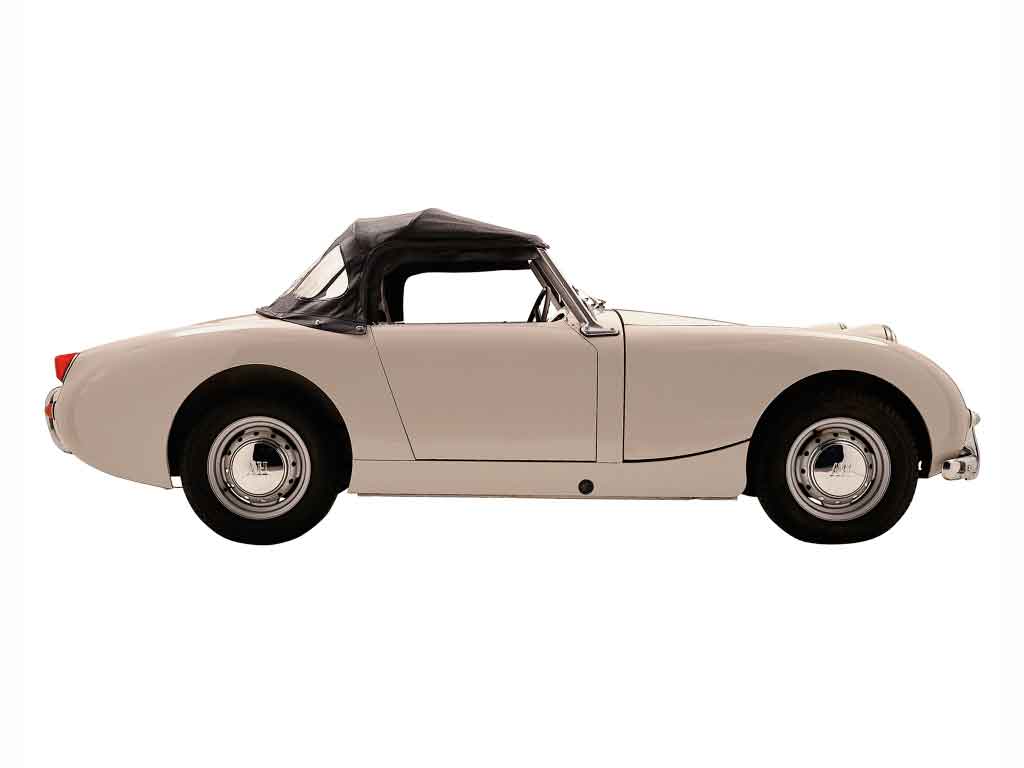
1961 MkII Mechanically identical to its predecessor, it’s goodbye to the ‘frog eyes’ but hello, to an opening boot, although there are still no door handles or locks. Badge-engineered doppelganger MG Midget has a different grille. Front brakes are upgraded to discs in 1962 and there’s a more powerful 55bhp, 1098cc engine.

1964 MkIII The third iteration is still powered by the 1098cc A-series, but it’s now fitted with larger main bearings for improved engine longevity. There’s also a marginal power hike of 3bhp. The doors now have external handles. Other changes include wind-up windows and a new fascia, plus semi-elliptic rear springs in place of the earlier quarter-elliptics for an improved ride quality.

1966 MkIV Tuned 1275cc A-Series engine raises power to a heady 65bhp and a proper convertible hood replaces the stow-away item. A 1969 facelift brings Rostyle wheels, black sills and grille, new badging and quarter-bumpers rather than full width. British Leyland’s association with the Healey badge ends, so the final 1022 are sold as Austin Sprites. Production ends in 1971 but Midgets are built until 1980.
